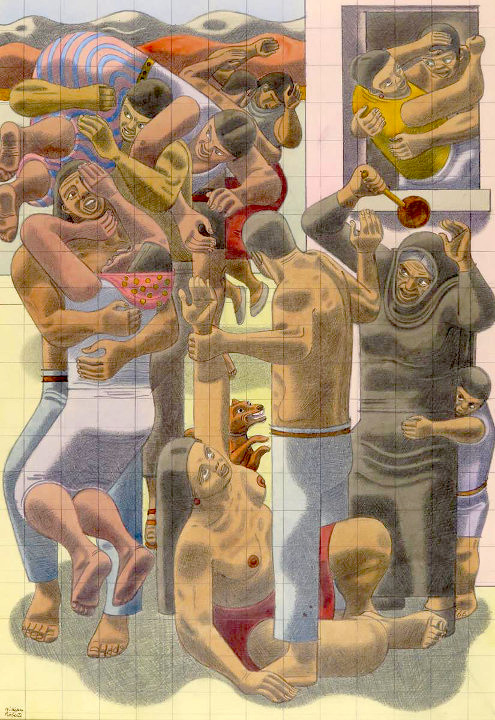AN ENGLISH CUBIST
WILLIAM ROBERTS:
The Rape of the Sabines – study
Copyrighted material on this page is included as 'fair use', for the purpose of study, review or critical analysis only, and will be removed at the request of the copyright owner. Catalogue information based on the catalogue raisonné by David Cleall. For this and full details of the exhibitions cited, see the links below. Any auction prices quoted may not include all fees and taxes, such as VAT and Artist's Resale Right charges.

The Rape of the Sabines – study, 1955
Pencil and watercolour, 50.8 cm x 34.3 cm
The rape – i.e. abduction – of the Sabine women was an incident in the legendary history of Rome. Around 750 BC, according to the Roman historian Livy, Rome feared that the status it had achieved could not be sustained as it had insufficient womanfolk to rear a new generation. When appeals to its neighbours for intermarriage failed, the Romans invited neighbouring tribes to solemn games held in honour of the god Neptune. 'Many people . . . gathered for the festival, especially those who lived nearest, the inhabitants of Caenina, Crustumium, and Antemnae. The Sabines, too, came with all their people, including their children and wives. They were hospitably entertained in every house, and when they had looked at the site of the City, its walls, and its numerous buildings, they marvelled that Rome had so rapidly grown great. When the time came for the show, and people's thoughts and eyes were busy with it, the preconcerted attack began. At a given signal the young Romans darted this way and that, to seize and carry off the maidens. In most cases these were taken by the men in whose path they chanced to be. Some, of exceptional beauty, had been marked out for the chief senators, and were carried off to their houses by plebeians to whom the office had been entrusted . . . The sports broke up in a panic, and the parents of the maidens fled sorrowing' (Ab Urbe Condita I.9, tr. Benjamin Oliver Foster, 1919). Subsequently, the abducted women supposedly became reconciled to their situation. Roberts sets the incident in the twentieth century, and seems to envisage it taking place on the Sabines' own territory.
Notes by John Roberts say that the woman brandishing a ladle was based on the woman, known as 'Old Mother Dry Rot' by William Roberts, who had occupied part of the artist's house in St Mark's Crescent when the Roberts family first moved there in 1946, and who at one point had to be bound over at Albany Street police station to keep the peace after attacking Sarah Roberts with a soup ladle.
PROVENANCE: Purchased from the artist by Ernest Cooper > Sotheby's 22 Nov. 1972 (£450) > F. Manzi > Christie's 5 Mar. 1999 (£4,140) > ? > Woolley & Wallis, Salisbury, 29 Nov. 2017 (£35,392)
EXHIBITION HISTORY: Southampton 1957 (on loan), Tate Gallery 1965 and tour, Worthing 1972, Newcastle 2004
Home page | Chronology | Bibliography | Collections | Exhibitions
News | Gallery | Auction results | The artist’s house | Contact
List of works illustrated on the site
Catalogue raisonné:
chronological | alphabetical